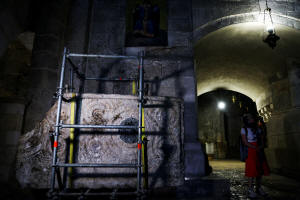Church of the Holy Sepulchre's ancient altar rediscovered, researchers
say
 Send a link to a friend
Send a link to a friend
 [April 13, 2022]
By Rinat Harash [April 13, 2022]
By Rinat Harash
JERUSALEM (Reuters) - Pressed against a
wall in a back corridor of Jerusalem's Church of the Holy Sepulchre, a
stone slab bore testimony only to the graffiti etched on it by
multitudes of pilgrims through the ages.
But the 2.5 x 1.5 metre stone turned out to be far more precious when
its other side was exposed during recent renovations at the church, the
traditional site of Jesus's crucifixion and burial.
Researchers believe the elaborate looping ornaments they found on the
long-hidden part of the slab indicate it was once the decorated front of
a medieval high altar that took pride of place centuries ago in one of
Christianity's holiest sites.
"You cannot see it now, but originally it was inlaid with pieces of
precious marble, pieces of glass, pieces of small, finely made marble,"
said Amit Re'em, Jerusalem regional archaeologist for the Israel
Antiquities Authority.
"It was shining and this was a really amazing artefact," said Re'em, who
conducted the research with Ilya Berkovich of the Austrian Academy of
Sciences.
They identified the unique decoration method as "Cosmatesque", which
combines Classical, Byzantine and early Islamic art in which finely cut
tiles of colourful marble are used to fill in circular engravings on the
stone.

"It stood at the apex, at the sanctuary of the Church (of the Holy Sepulchre)," Re'em said.
"All the eyes of the believers, of the pilgrims, (went) to this object.
And right above it and around it, all the high priests, the priests and
the monks of the church did all the liturgy, the main liturgy of the
church, on the table, right here on the table of this altar," he said.
[to top of second column]
|

A stone slab said to be the decorated frontal of the Crusader-era
high altar of the Church of the Holy Sepulchre according to
researchers at the Israel Antiquities Authority and Austrian Academy
of Sciences, is seen in the Church of the Holy Sepulchre after it
was recently turned over during renovations and its significance
rediscovered, in Jerusalem's Old City, April 11, 2022. Picture taken
April 11, 2022. REUTERS/Ronen Zvulun
 Similarly decorated altars have been
found inside churches in Rome dating to the 12th and 13th centuries,
the researchers said.
They believe the relic in Jerusalem corresponds with past
archaeological findings and with pilgrims' accounts of the
consecration of the church by the Crusaders and the forming of its
main altar in 1149.
The altar was used by the Catholic clergy to celebrate mass until
the Crusaders left Jerusalem, Re'em said. Afterwards it was used by
the Greek Orthodox church until it was damaged in a fire in 1808,
cast aside and forgotten until the recent renovations, he said.
Archbishop Aristarchos of Constantina, the chief secretary of the
Greek Orthodox Patriarchate of Jerusalem, welcomed such research at
the church.
"Works from people of art, people of archaeology, contribute to us,
contribute to the belief of the church, to the conviction of the
church, that this is the place...on which Jesus Christ was
crucified...buried and from which he came to resurrection," he told
Reuters.
The researchers' findings are due to be published by the end of the
year by Israel's Exploration Society.
(Editing by Jeffrey Heller and Angus MacSwan)
[© 2022 Thomson Reuters. All rights
reserved.] This material may not be published,
broadcast, rewritten or redistributed.
Thompson Reuters is solely responsible for this content. |